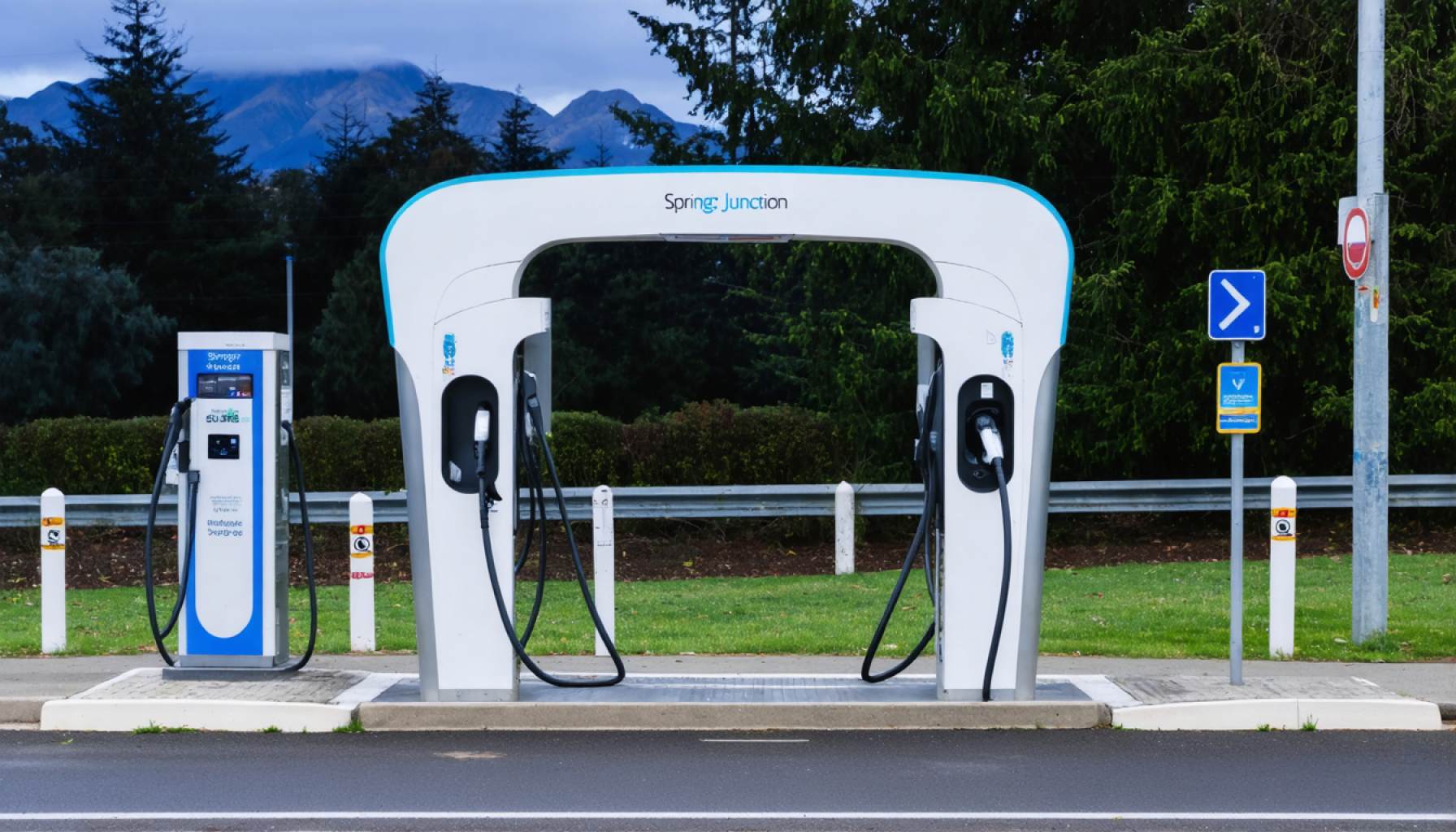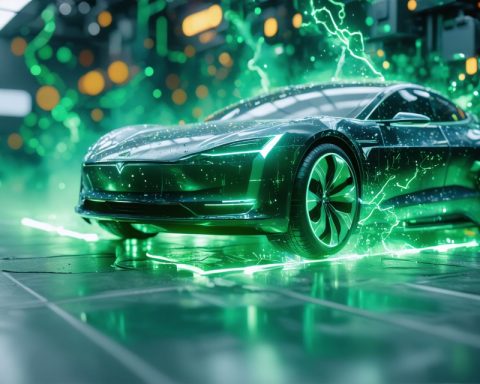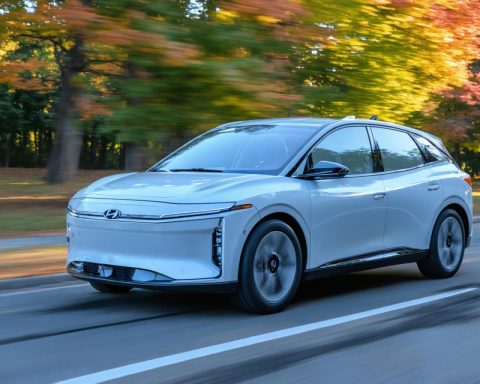- Springs Junction, a critical point between Christchurch and Nelson, spearheads innovation in New Zealand’s electric vehicle network.
- Meridian addressed the challenge of limited grid capacity by utilizing repurposed Nissan Leaf batteries in three battery energy storage system (BESS) units.
- The BESS units store energy during off-peak times to power EV chargers during the day, showcasing an innovative recycling solution.
- A digital dashboard provides real-time updates on energy availability, assisting drivers in planning their journeys through the South Island.
- The project emphasizes sustainable practices and community collaboration, urging sensible energy use amid initial limitations.
- Springs Junction is part of broader efforts funded by the Energy Efficiency and Conservation Authority, with future sites planned for Haast and Harihari.
- This initiative highlights Meridian’s commitment to advancing sustainability and transforming remote regions into modern energy hubs.
Nestled in the heart of the South Island’s lush, verdant landscapes lies Springs Junction, now a beacon of progress in New Zealand’s expanding electric vehicle (EV) network. This once-remote spot, linking Christchurch and Nelson, has become a pivotal character in the story of sustainable travel, thanks to a groundbreaking endeavor by Meridian.
A daunting challenge unfolded over two years ago: Springs Junction’s power grid, straining at full capacity, left little room for traditional charging stations. For 19 hours daily, a meager 4kW dripped through the network—a mere whisper of power, barely sufficient to heat a cup of tea. This bottleneck could have halted ambitions, yet instead, it sparked brilliance within Meridian’s team.
Meridian’s solution danced between innovation and necessity. Leveraging the power of recycling and storage, three towering battery energy storage system (BESS) units, constructed from repurposed Nissan Leaf batteries, now stand as guardians of continuity. These units quietly sip from the grid’s excess during the tranquil hours of late night—when cities slumber—before breathing life into EV chargers by daylight.
Such ingenuity extends beyond technology. To ensure drivers navigate this evolving landscape with confidence, a digital dashboard offers real-time updates on the station’s status. Every five minutes, a virtual pulse reveals the energy within, empowering travelers to chart their course through the South Island’s undulating terrain, making each decision as informed as a sailor reading the winds.
Meridian urges users to tread lightly, taking only what they need amidst these initial kW limitations—a call to collective action and Kiwi creativity that resonates through the hills. This project has been a compass of sorts, guiding Meridian’s team through an odyssey of unforeseen hurdles, testing minds and forging stronger communal ties.
While Springs Junction now strums with high-tech hums of renewal, these efforts mark but a waypoint in a grander journey. Part of a constellation of projects sparked by the Energy Efficiency and Conservation Authority’s funding, Meridian’s vision is alight with aspirations for even the remotest corners of New Zealand. Sites at Haast and Harihari beckon, each awaiting their turn to echo with the rhythm of a new era.
As Meridian’s enterprise continues to bloom across the island, Springs Junction stands as a testament to what thoughtful persistence and a commitment to sustainability can achieve. It’s a narrative of individuals willing to rethink constraints, transforming remote locales into shining outposts on the roadmap of the future.
The Future of Electric Vehicles: How Springs Junction is Leading New Zealand’s Green Revolution
Introduction
Springs Junction, once a quiet waystation on New Zealand’s South Island, is now a pioneering beacon in the electric vehicle (EV) revolution, showcasing innovative solutions to infrastructure limitations. With support from Meridian Energy, this location exemplifies the potential of sustainable energy practices. This exploration will delve deeper into the transformative impact of such initiatives, addressing critical questions, industry trends, and actionable insights.
Understanding the Challenges and Innovations
Initially, Springs Junction faced a significant hurdle due to its limited power grid—capable of delivering just 4kW for most of the day. Such constraints could have stunted the deployment of typical EV charging stations. However, leveraging creativity and sustainability, Meridian Energy introduced a cutting-edge solution: the use of recycled Nissan Leaf batteries to create robust Battery Energy Storage System (BESS) units. These systems adeptly harness excess grid power during low-use periods and deploy it to fuel EV chargers during peak demand.
Real-World Use Cases
The transformation of Springs Junction provides a viable blueprint for other remote locations around the world where grid capacities present similar challenges. The use of recycled batteries not only assures operational efficiency but also promotes circular economies by reusing automotive batteries that would otherwise go to waste.
Market Forecasts & Industry Trends
According to a report by BloombergNEF, the global demand for EVs is expected to grow exponentially over the next decade. In New Zealand, the government aims to become one of the leaders in zero-emission vehicle adoption, forecasting an increase in EV usage through supportive infrastructure and policy initiatives. The success of projects like Springs Junction will be pivotal in meeting these goals.
Security & Sustainability
By integrating digital dashboards that update every five minutes, Springs Junction ensures transparency and reliability for users. This technology promotes a more informed driving experience, allowing EV users to plan their journeys with confidence. Furthermore, BESS units improve grid stability and enhance sustainability, reducing reliance on traditional energy sources.
Controversies & Limitations
While the use of recycled batteries is both innovative and sustainable, it does come with challenges. The longevity and efficiency of second-life batteries can be variable, and ongoing maintenance and monitoring are essential. Critics may also point toward the initial costs and complexity of setup.
Insights & Predictions
The success at Springs Junction paints an optimistic picture for similar installations in remote areas. It anticipates a future where geography does not limit the adoption of green technologies, providing a model for rural electrification using sustainable methods.
Actionable Recommendations and Quick Tips
1. Embrace Battery Recycling: Organizations aiming to promote EV infrastructure should consider repurposing automotive batteries.
2. Leverage Digital Tools: Utilize real-time monitoring for user transparency and informed decision-making.
3. Plan for Gradual Scaling: Start with a pilot project, measure the outcomes, and then scale the model to other regions.
4. Collaborate for Funding: Secure governmental or institutional funding targeting sustainable initiatives.
For more on sustainable energy practices and initiatives, visit [Meridian Energy](https://meridianenergy.co.nz).
In conclusion, Springs Junction’s evolution from an underpowered stopover to a sustainable energy hub highlights the incredible potential for innovation in the face of adversity. As technology progresses, such projects will be crucial in fostering a greener planet, demonstrating that with creativity, every challenge can catalyze opportunity.














